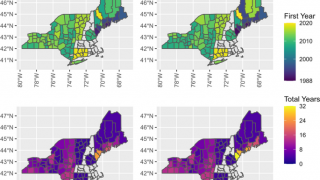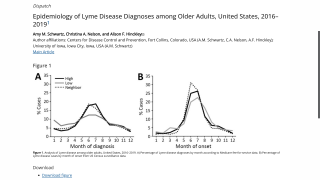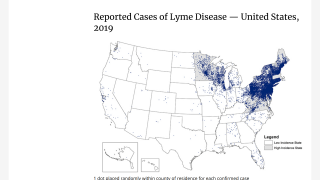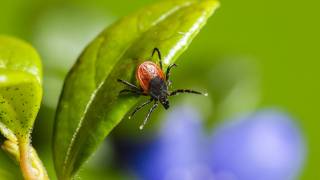Pittsburgh Suburbs Have Become Lyme Disease Hot-Spot

New research found that pediatric Lyme disease cases have significantly increased over a 10-year period in western Pennsylvania.
And, the highest burden of infection was reported in non-rural areas.
Which means, children from cities and suburbs were more likely to be seen in a hospital emergency department with symptoms of early Lyme disease, such as a rash.
Whereas children from rural areas were more likely to first be seen by their primary care provider with symptoms of late Lyme disease, such as arthritis.
“This study details the shift of western Pennsylvania from a Lyme-naïve to a Lyme endemic area, highlighting the change in symptoms seen clinically and the types of doctors caring for these patients,” said Brian Campfield, M.D., pediatric infectious diseases specialist, Division of Infectious Diseases, Children’s Hospital, in a press release.
Pennsylvania has led the nation in confirmed cases of Lyme disease for three straight years, and for the first time, deer ticks have been found in each of Pennsylvania’s 67 counties.
Lyme disease cases are concentrated in the Northeast and upper Midwest, with 14 states accounting for over 96% of cases reported to Centers for Disease Control and Prevention (CDC).
In 2013, the last year of this new study, 285 children were diagnosed with Lyme disease.
Recent Lyme Disease news:
Lyme disease, caused by the bacteria, Borrelia burgdorferi, is transmitted through the bite of a tick commonly known as the deer tick or black-legged tick. The infection can be treated with an antibiotic, but if it is not treated it can lead to many problems, including muscle and joint aches, facial weakness, arthritis and brain inflammation.
There is not a commercially available vaccine to prevent Lyme disease.
But, a vaccine candidate, VLA15-101, showed the potential to protect humans against the majority of Borrelia species pathogenic for humans.
Valneva, the manufacturer of VLA15-101, recently reported positive Phase 1 study results.
Andrew Nowalk, M.D., Ph.D., pediatric infectious diseases specialist, Division of Infectious Diseases, Children’s Hospital, said “Being a geographically distinct area that is west of the Appalachians and south of the Great Lakes, it is concerning that few natural geographic barriers exist to limit the spread of the tick or the infection that causes Lyme disease.”
“It is very possible that other areas throughout the Midwest, Ohio River Valley, and Southeast will experience a similar change in Lyme disease burden. Perhaps, our clinical experience can inform public health initiatives and health care utilization needs,” said Dr. Nowalk.
One of the underlying causes for this change is the distribution and abundance of the primary Lyme disease vectors: Ixodes scapularis Say and Ixodes pacificus Cooley and Kohls in eastern and western North America, reported a 2015 study.
This study reported these ticks to exist in the environment where temperature and relative humidity directly affect their development, survival, and host-seeking behavior.
The UPMC study was supported by National Heart, Lung, and Blood Institute grant K08HL128809 and National Institute for Allergy and Infectious Diseases grant F30AI114146. No conflicts of interest were disclosed.
Our Trust Standards: Medical Advisory Committee
- Lyme Disease in Children on the Rise in Western Pennsylvania, Children’s Hospital of Pittsburgh of UPMC Study Shows
- Linkages of Weather and Climate With Ixodes scapularis and Ixodes pacificus (Acari: Ixodidae)
- The novel Lyme borreliosis vaccine VLA15 shows broad protection against Borrelia species
- Insights from the Geographic Spread of the Lyme Disease Epidemic


























